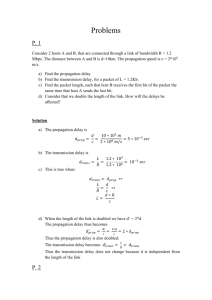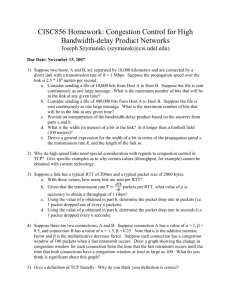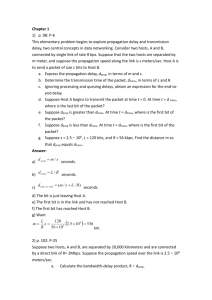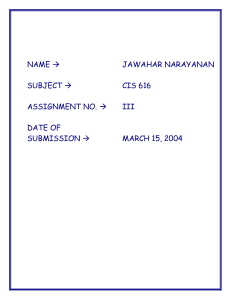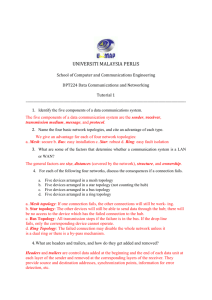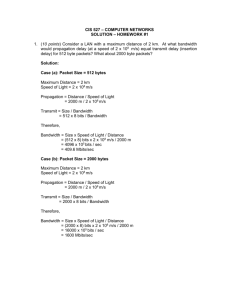Chapter 1 :answer of the problems
advertisement
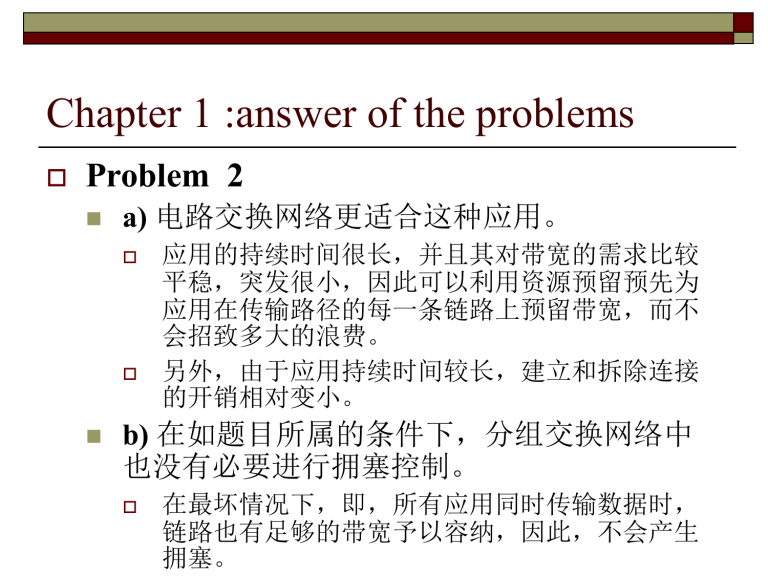
Chapter 1 :answer of the problems Problem 2 a) 电路交换网络更适合这种应用。 应用的持续时间很长,并且其对带宽的需求比较 平稳,突发很小,因此可以利用资源预留预先为 应用在传输路径的每一条链路上预留带宽,而不 会招致多大的浪费。 另外,由于应用持续时间较长,建立和拆除连接 的开销相对变小。 b) 在如题目所属的条件下,分组交换网络中 也没有必要进行拥塞控制。 在最坏情况下,即,所有应用同时传输数据时, 链路也有足够的带宽予以容纳,因此,不会产生 拥塞。 Chapter 1 : answer of the problems Problem 3 a) We can n connections between each of the four pairs of adjacent switches. This gives a maximum of 4n connections. b) We can n connections passing through the switch in the upperright-hand corner and another n connections passing through the switch in the lower-left-hand corner, giving a total of 2n connections. Chapter 1 : answer of the problems P63.4 Tollbooths are 100 km apart, and the cars propagate at 100km/hr. A tollbooth services a car at a rate of one car every 12 seconds. There are ten cars. a) It takes 120 seconds, or two minutes, for the first tollbooth to service the 10 cars. Each of these cars have a propagation delay of 60 minutes before arriving at the second tollbooth. Thus, all the cars are lined up before the second tollbooth after 62 minutes. The whole process repeats itself for traveling between the second and third tollbooths. Thus the total delay is 124 minutes. b) Delay between tollbooths is 7*12 seconds plus 60 minutes, i.e., 61 minutes and 24 seconds. The total delay is twice this amount, i.e., 122 minutes and 48 seconds. Chapter 1 : answer of the problems P63. 5 a) Packet Switched Virtual-Circuit Networks ( F h) / R The time to transmit one packet onto a link is . The time to deliver the packet over Q links is. t s Q ( F h) / R Thus the total latency is . b)Q(Packet Switched Networks F 2h) / R c) Circuit-Switched Networks Q ( F h) / R Because there is no store-and-forward delays at the t s (h F ) / R links, the total delay is: Chapter 1 : answer of the problems P64: 7 Consider the first bit in a packet. Before this bit can be transmitted, all of the bits in the packet must be generated. This requires 48 * 8 sec=6msec. 64 103 The time required to transmit the packet is 48 * 8sec= 384 sec 1 10 6 Propagation delay = 2 msec. The delay until decoding is 6msec + + 2msec = 8.384msec 384 sec Chapter 1 : answer of the problems P65: 14 bandwidth-delay product=R*tprop=40,000 bits maximum bits=min(R*tprop, L)=40,000 bits the bandwidth-delay product of a link is the maximum number of bits that can be in the link Bandwidth*Delay=number of bits in flight to fill link 1-bit width=propgation speed* ttransmits a bit =10-6*2.5*108=250 m s/R Chapter 1 : answer of the problems P66. 15 1-bit width=s/R s/R=m, so R=s/m=2.5*108/107=25bps P66. 16 bandwidth-delay product= R*tprop=109*107/(2.5*108)=40,000,000 bits maximum bits=min(R*tprop, L)=min(40,000,000, 400,000)=400,000 bits the bandwidth-delay product of a link is the maximum number of bits that can be in the link 1-bit width=propgation speed* ttransmits a bit =2.5*108/109=0.25m

